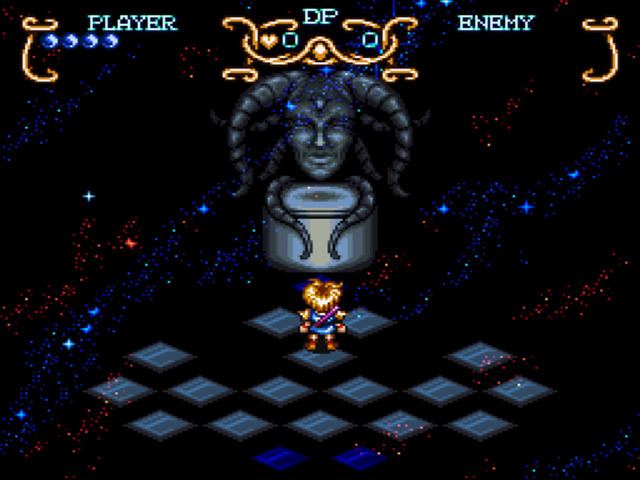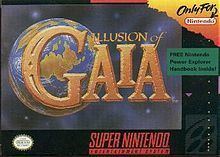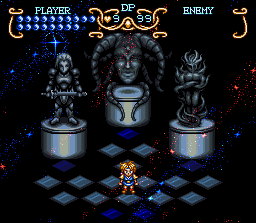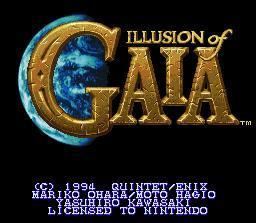9.6 /10 1 Votes9.6
4.7/5 eBay Producer(s) Yasuyuki Sone Initial release date 27 November 1993 Genre Action role-playing game | 4.9/5 Emuparadise Director(s) Masaya Hashimoto Designer(s) Tomoyoshi Miyazaki Composer(s) Yasuhiro Kawasaki | |||||||||||||||||||||||||||||||||
Similar Soul Blazer games, Enix games, Action role-playing games | ||||||||||||||||||||||||||||||||||
Illusion of gaia video walkthrough 1 2
Illusion of Gaia (Japanese: ガイア幻想紀, Hepburn: Gaia Gensōki, lit. "The Gaia Fantasy Chronicles"), known in Europe and Australia as Illusion of Time, is an action role-playing game that was released for the Super Nintendo Entertainment System, in Japan on November 27, 1993, and in North America on September 1, 1994. Developed by Quintet, Enix published the game in Japan, and Nintendo published it worldwide.
Contents
- Illusion of gaia video walkthrough 1 2
- Game theory illusion of gaia world wonders
- Gameplay
- Setting
- Story
- Characters
- Development
- Version differences
- Merchandise
- Reception
- References

Illusion of Gaia was scored by Yasuhiro Kawasaki. Moto Hagio, the influential manga artist, is credited with the character designs. Novelist Mariko Ōhara worked on the story.

Game theory illusion of gaia world wonders
Gameplay

While Illusion of Gaia has a large cast of characters, Will, Freedan and Shadow are the only playable characters in the game. They each have unique abilities, and certain areas are impassable without a specific character. The characters gain techniques as part of the story. Will's techniques are all based on reaching new areas with incidental combat applications, while Freedan's techniques are more combat-oriented. Shadow arrives late in the game, but being such a powerful character, he causes Freedan to be nearly obsolete.
Combat is relatively simple. Characters share the same health and defense scores, but have different levels of strength. Freedan, for example, does noticeably more damage, and has a longer reach than Will. In turn, Shadow does more damage than Freedan. Attacks are almost exclusively melee, using Will's flute, Freedan's sword or Shadow's pseudopod. Enemies' health bars appear upon attacking, displaying as a series of red spheres that represent hit points. Bosses cannot be revisited, and enemies do not reappear unless Will loses all his lives or completely exits an area and then returns.

Illusion of Gaia has a general design that is uniquely simple as RPGs go. The game eschews the experience system of typical role-playing video games; instead, the game has a more novel system for advancing the player character's statistics. Defeating all enemies in a room earns the player a permanent stat bonus in the form of a jewel. These jewels boost attack, defense or health power. While returning to a cleared area will cause enemies to reappear, the bonuses for defeating them again do not. Also, after an enemy is killed, it will leave a stone — either a small or a great one. Collecting 100 of these allows you to restart closer to where you died with all enemies still defeated, by earning a new life.

Also, the game has no currency or equipment systems. There is only one healing item (herbs), and only a small number of those in the game. Unlike most games of its type, formerly visited areas become impossible to revisit almost immediately after the story progresses beyond them until the last third of the game, though areas from the first two-thirds of the game remain inaccessible. The only sidequest in the game, finding Red Jewels, thus becomes impossible to complete if the player fails to find them before advancing the story.
Like most RPGs, the game has only one difficulty setting. Saving is accomplished at Dark Spaces located throughout each level — including areas without enemies, such as Will's hometown. Will can recover lost health within the Dark Spaces, and occasionally switch forms or gain new abilities.
Setting
Illusion of Gaia is set in a partially historical but mostly fantasy-based version of Earth. The game contains several real-world sites, such as Incan ruins, the Nazca Lines, Angkor Wat, the Great Wall of China and the Egyptian pyramids. Each of these ruins hold a piece to the final puzzle, unveiled at the top of the infamous Tower of Babel.
It is firstly believed to be the age of exploration (a period roughly corresponding to the 16th century; Christopher Columbus is mentioned at least once), and explorers have begun scouring the world in search of ancient ruins and the lost treasures and secrets within. Many return with nothing, and some are simply never seen again. Will, the protagonist of the game, is a survivor of one such ill-fated expedition. He accompanied his father, a famed explorer, on a sea journey to uncover the secrets of the Tower of Babel, but the explorers met with a mysterious disaster. Somehow Will managed to make it back to his hometown, but he does not remember how.
Story
When the game begins, Will stumbles into a "Dark Space" where he meets a strange being called Gaia. Gaia tells Will that he must leave his home and save the world from a coming evil. A comet is approaching, and it will bring ill fortune to the world. As he travels, Will gains the ability to change into other forms, each with special powers: Freedan, a dark knight, and Shadow, a solid form of energy.
It is later revealed that the comet is in fact an ancient weapon used during the last Blazer War, and has the power to change the shape of the world. In the ruin of Angkor Wat, it is discovered that the comet's repeated approach and effect on the Earth has prevented the world and mankind from evolving into a more modern state.
Will and his friends travel the world and collect artifacts known as Mystic Statues. At the climax, Will and Kara reach the Tower of Babel, where it is then revealed that Will is the Dark Knight, and Kara is the Light Knight. The two knights join to form Shadow and use the ancient statues to release the ultimate power, the firebird.
Attacking the comet directly, which soon manifests itself as Dark Gaia, Will and Kara manage to destroy its power, returning the world to normal. The spirits of Will's parents inform them that the world will return to normal and that no one will conserve any memories of the adventure. Saddened by that fact, Will and Kara join one last time as Shadow to return to Earth.
The final scene is left ambiguous. All of Will's friends are depicted in what appears to be a modern-day school, implying that even if they forgot about their time together, they remained friends in the "real" world.
Characters
Illusion of Gaia features only one playable character at a time: either Will, a boy who develops psychic powers after surviving a shipwreck during an exploratory expedition with his father, or his alter egos Freedan and Shadow. However, a large group of non-player characters accompany Will from region to region.
Included are Will's classmates and friends known collectively as the seaside gang:
The other characters who join Will are:
Will and his friends face many enemies in their journey to uncover the secret of the Tower of Babel, both those who protect the clues to the mystery and those who seek its power for themselves. A number of powerful demons guard the priceless treasures of lost civilizations, while the human but power-mad King Edward and Queen Edwina contact Jackal, an assassin, to tail Will and Kara through their journeys. Neil's parents are the driving force behind the Rolek company, which is also the driving force behind the world's slave trade. It is later revealed that they are replaced by members of the Moon Tribe. The Tribe themselves are encountered numerous times throughout the journey, being living shadows that lost their corporeal forms after being subject to the comet's light. Will's other notable encounters include Sam, a slave who helps him give Lance's memory back, and his adoptive guardians, Lola and Bill.
Development
A pre-release, English-language version of Illusion of Gaia was leaked onto the World Wide Web in the form of a ROM file. This pre-release version contained a number of differences in presentation and translation as compared to the final English-language version. For example, the prototype version contained a different title screen, based on the original Japanese-version title screen. The pre-release version portrayed small sprites of the game's main characters running on the surface of a comet. The final version released in the United States came bundled with an instruction booklet that contained one image of an early title screen, which still contained the small sprites at the bottom; however, this version had the correct title. In the leaked prototype, the title was presented as SoulBlazer: Illusion of GAIA.
Another notable difference was that many of the original Japanese names were in the English-language pre-release version. For instance, the character "Will" was named "Tim," the character "Kara" was named "Karen" (one instance of this name remained in the released version), and so on.
Some of the script of the English-language prototype was different from the final version. An example included the character "Jeweler Gem" being portrayed as more "sinister."
Finally, Nintendo was not listed in the pre-release version's title credits. It is assumed that the prototype was developed before Nintendo of America decided to publish and market the game in the United States. When Nintendo decided to be the United States publisher, the title was changed and a logo was specifically redesigned to resemble the logo of Nintendo's popular The Legend of Zelda game franchise.
Version differences
In keeping with Nintendo of America's censorship policies at the time of publication, numerous changes were made to the game to make certain story elements less dark. Most notably, the native tribe encountered near Angkor Wat were originally cannibals, with the skeletal remains lying around the village being the remnants of their own tribesmen, whom they had eaten to survive.
Additionally, numerous religious references were changed or completely removed. Will's school was initially a Sunday school run by a priest and held in a Christian church; the American release simply identifies the building as a school and replaces a cross with a statue. In the Japanese release, speaking with the priest would cause him to begin leading Will in a prayer; in the American release, the teacher leads Will in reciting a poem. A translation error in a sequence near the middle of the game suggests that Seth's consciousness has been absorbed into that of a sea monster named "Riverson", whereas the Japanese version explains that he has been transformed into a "Leviathan". A line from the game's climax, in which Will and Kara comment, upon seeing Earth from outer space, that this is what it must feel like to be God, was also removed.
A notable change to gameplay itself is that the Japanese and American releases feature a different boss in the Sky Garden. In the Japanese version, the boss is simply a giant bird. In the American release, the boss is a winged Babylonian statue with talons. It is suggested that the American boss could be the creators' initial vision, and tied in with the idea that the Sky Garden was once the Hanging Gardens of Babylon; the developers used the port of the game to "tidy up" the boss, as they were dissatisfied with the bird/snake hybrid present in the original release.
In Europe, the game was released in English, German, French and Spanish. Of these, only the French version made significant changes, adding some new references to existing people or myths, such as Edgar Degas, Franz Kafka, Chrysaor and Nosferatu.
Merchandise
Nintendo released a bundle pack in the United States that, while supplies lasted, included a "one size fits all" T-shirt that featured the logo, Freedan and Shadow. As a Nintendo-published title in the U.S., the game received special attention in Nintendo Power magazine and additional merchandise was sold in the Super Power Supplies catalog for subscribers.
Reception
Quintet reported that Illusion of Gaia sold 200,000 copies in Japan, 300,000 copies in North America, and 150,000 copies in Europe, adding up to 650,000 cartridges sold worldwide. In comparison, Soul Blazer sold 295,000 cartridges worldwide.
GamePro praised the game's puzzle-solving elements, effect-heavy graphics, eclectic soundtrack and gentle difficulty slope. They added that "the game, however, has sacrificed the central theme that gave the original Soulblazer [sic] (and ActRaiser before it) a distinct sense of direction and purpose —— an impression that your good works have an ongoing impact on the game world. On the other hand, Illusion of Gaia enjoys a sense of worldliness that Soulblazer [sic] didn't have. ... you never know quite what's coming next, and that's the best thing that could be said about an RPG". Illusion of Gaia was rated the 186th best game made on a Nintendo system in Nintendo Power's Top 200 Games list in 2006.
